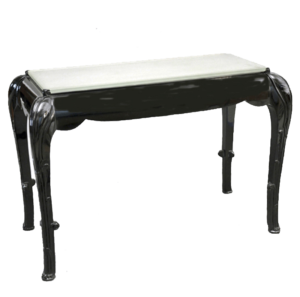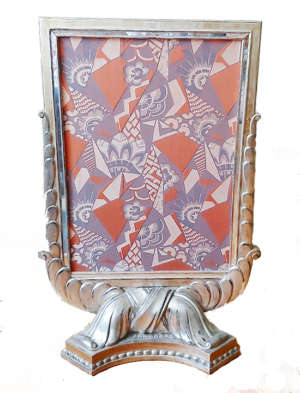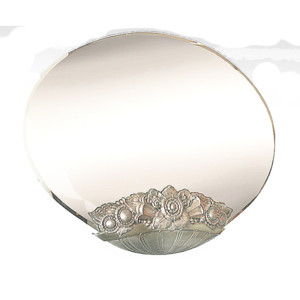Louis Sue, André Mare, La Compagnie des Arts Françise
Louis Sue (1875-1968), a painter and architect, and Andre Mare (1887-1932), also originally a painter, were the founders of the highly important firm La Compagnie des Arts Français.
Prior to their collaboration, Andre Mare began his artistic endeavors when he moved to Paris in 1904 to study at the highly esteemed école des Arts Decoratifs, then continuing his education at Academie Julian, where he first met Louis Sue, just prior to the out-break of World War I. By 1910, Mare’s increasing interest in the decorative arts leads him to design book bindings, furniture and ensembles.
During the war, his wife, Charlotte, supervised his designs in furniture, carpets and fabric. In the years of 1911-13, André Mare collaborated with influential artists in a controversial exhibit called “Maison Cubiste.” His paintings incorporated geometric elements that presaged the Cubist movement. During the war, Mare led the development of military camouflage by painting French artillery using his Cubist knowledge to deceive the eye of the opponent. Soon after, he published a book called Cubism et Camouflage.
Bordeaux born Louis Sue moved to Paris in 1895 in order to train as a painter. In 1912, he created Atelier Français, an interior decorating firm, after working with the famous courturier Paul Poiret as the officiator to the house’s decorative design department. Atelier Français produced furniture, textiles and ceramics. Additionally, he created perfume bottles for the fashion designer Jean Patou.
Individually, both Sue and Mare held great provenance in the decorative arts world, but together, their partnership was quite important producing a very distinctive and much admired style, and they were among the most important designers of the Art Deco movement.
By 1914, the two had become associated with one another and formed a partnership, and in 1919, they established La Compagnie des Arts Francais, which lasted until 1928. Not unlike Paul Follot and Jules Leleu, Sue et Mar created lavish furnishings inspired by eighteenth century models and early nineteenth century designs that drew on the motifs and luxury of the Louis XIV, Louis XV and Louis-Philippe periods, but Sue et Mare interpreted these styles in their own distinctive and modern way – stylized in the Art Deco manner, but retaining enough of their historical elements, especially form, to make them acceptable as being fully French, and to appeal to the somewhat less Avant-Garde client.
Rather than being rigidly geometric, like the work of their more avant-garde contemporaries such as Pierre Chareau and Robert Mallet-Stevens, their work is full of sensual curves. Their pieces often incorporated swags, flowers, fruits, and birds, design elements found in earlier French furniture and decoration, but all executed with the plump, bursting with ripeness feeling that was characteristic of their work. Elegant scallops, often complete the edges of pieces, sometimes ornamented simply with a motif of twisted rope carved into the wood. Feet of tables and chairs may feature a delicate scroll of wood. Luxurious materials were an important element of much French Art Deco – rare woods, lacquered surfaces, and inlays of ivory and mother-of pearl, and Sue et Mare incorporated these materials with great success in their work.
Sue et Mare were decorators. Sometimes, they would only be responsible for the furniture design, but other times, they would often be responsible for every detail of a home, which required them to apply their talents to every aspects of the decorative arts, from textiles to wallpaper, mirrors, lamps and other lighting, bronze accessories such as clocks and door handles, and, of course, the furniture. For their bronze work, they often worked with the sculptor Paul Vera. Sue et Mare as a duo designed works that were quite distinctive, elegant, and beautiful.
The Exposition International des Arts Decoratifs was originally planned to open in 1917, but the out-break of WW1 made that impossible. By the time the Exposition took place in 1925, styles had changed considerably, influenced by Cubism, the sleekness of machines, and African Tribal art. The exposition ran from April to October of 1925, and was held, of course, in Paris. From it, the term “Art Deco” was born. The exposition was intended to revive the flagging demand for French goods, as well to bring together different nations around the globe, and to develop a certain common aesthetic within the architectural and decorative arts world.

The pair received commissions for many projects, among them the French Embassy in Warsaw, the Embassy of France in Washington, DC, Jean Patou’s mansion, the Grand Salon for the ocean liner Ile de France and the staterooms for the steamship Paris were among their important commissions.

The distinctive and highly successful collaboration of La Compagnie des Arts Francais compelled critic Jean Badovici to comment that their work was “an admirable association of two dissimilar minds, which combined the best of their qualities to put them at the service of Beauty. One provides a sure and precise knowledge of a rigorous sense of geometry; the other a refined and delicate sensibility.”
As a duo, Sue et Mar contributed their eloquent and distinctive style to the development of one of the most prominent and influential movements in Twentieth Century design, and their work is still in demand today.
Showing all 3 results




